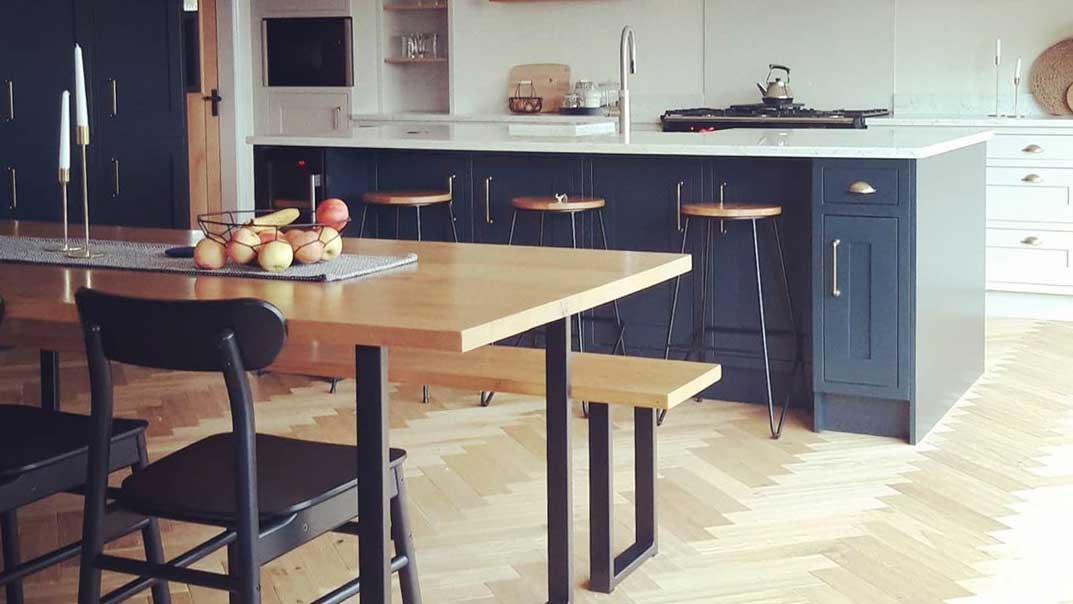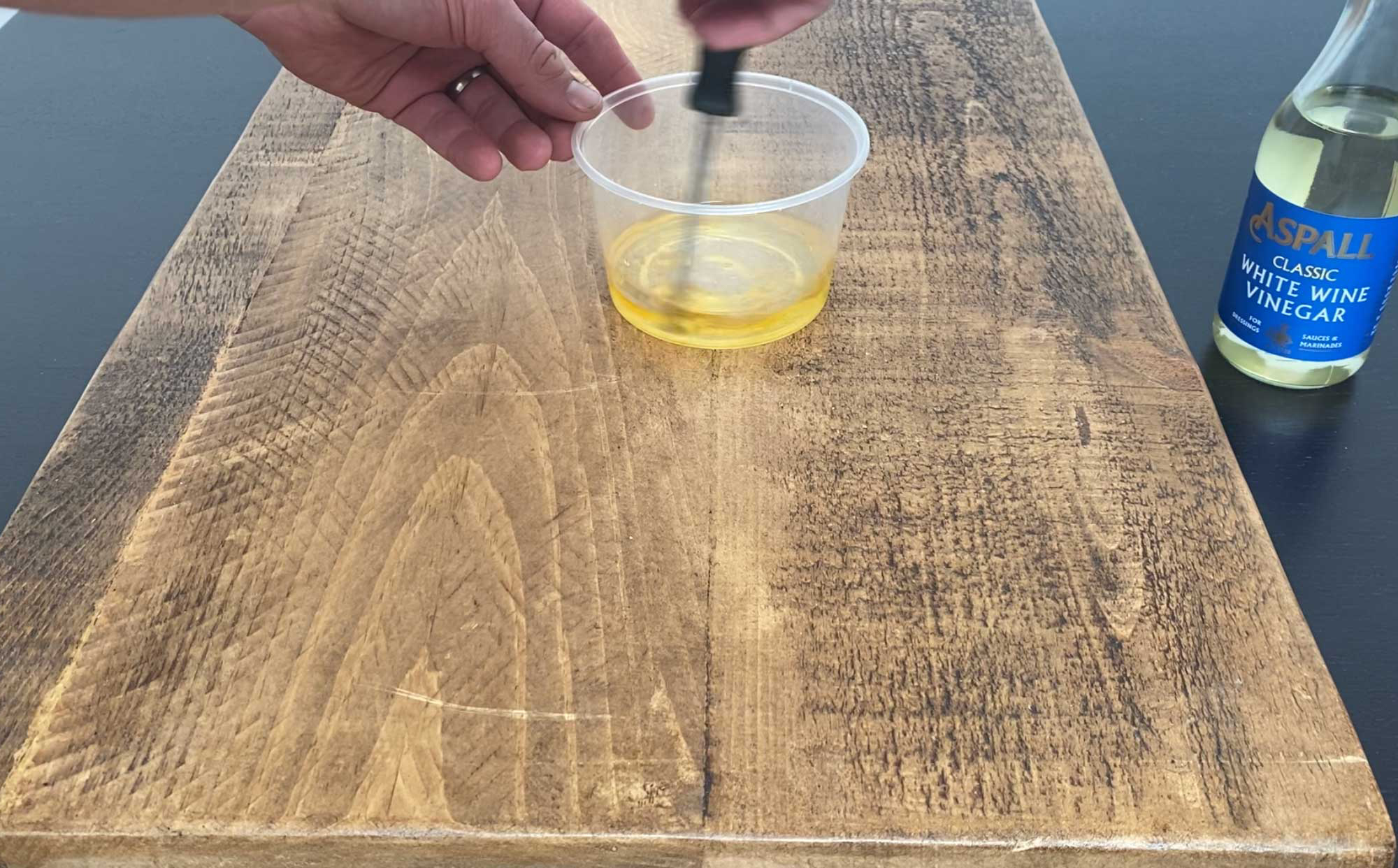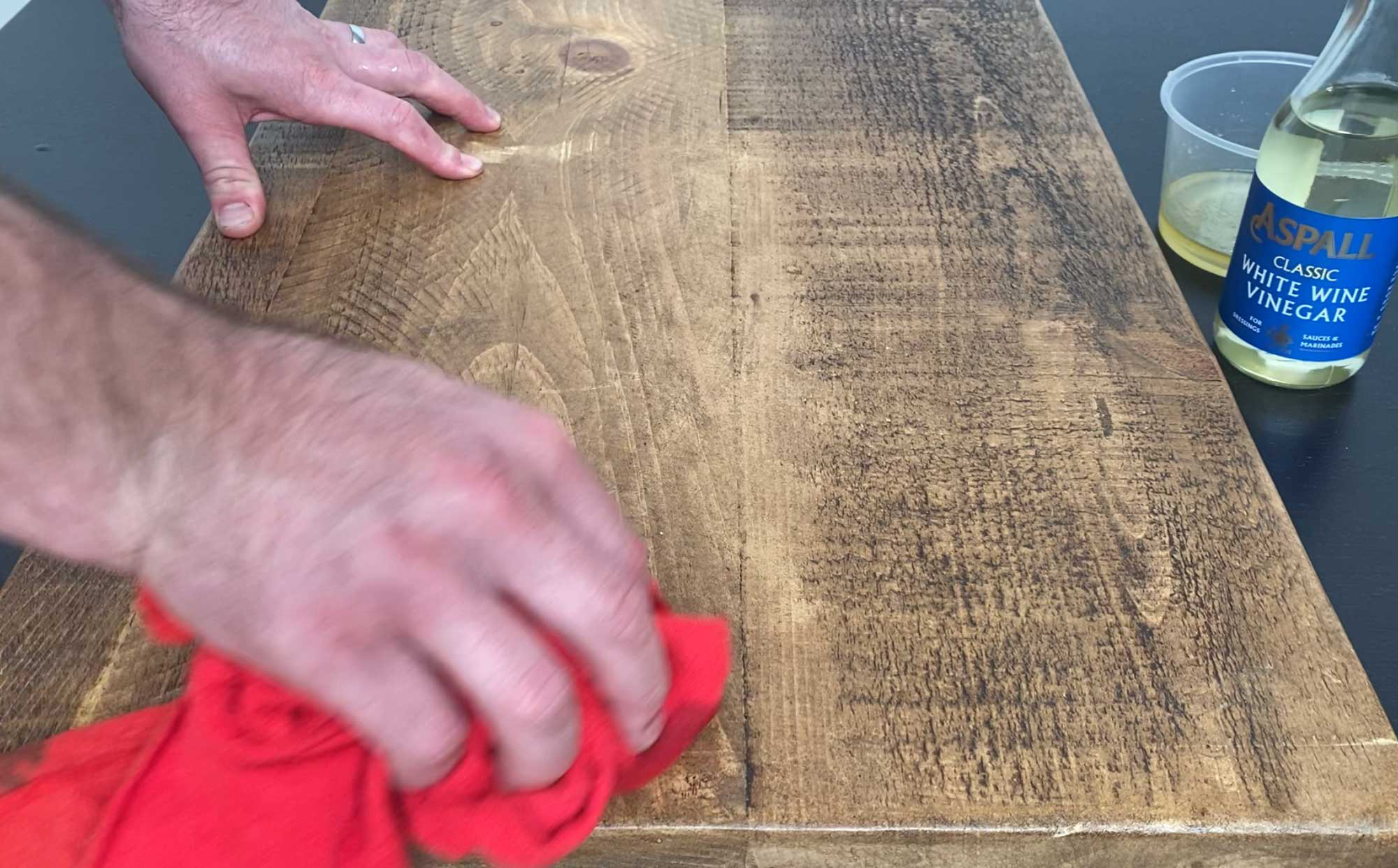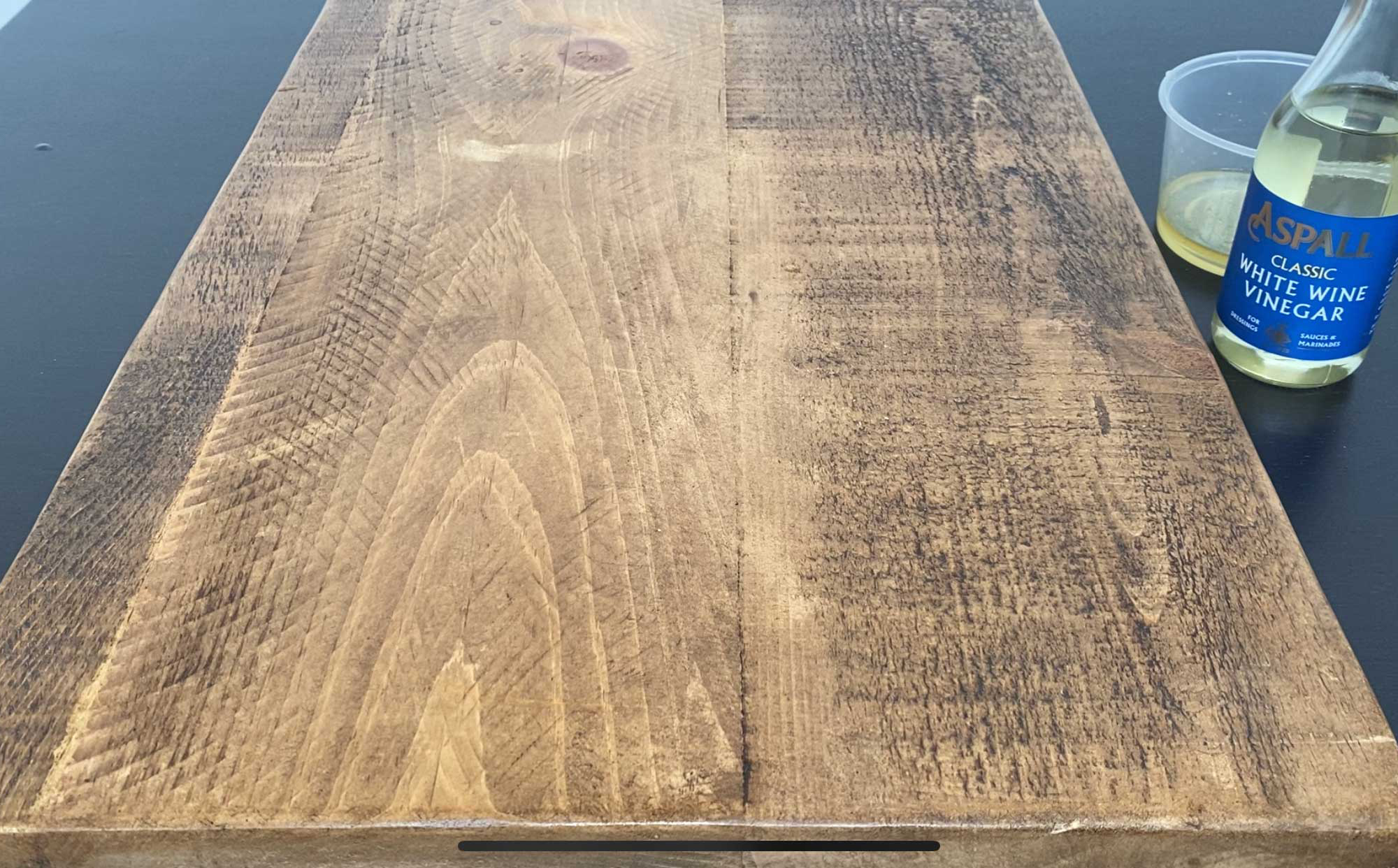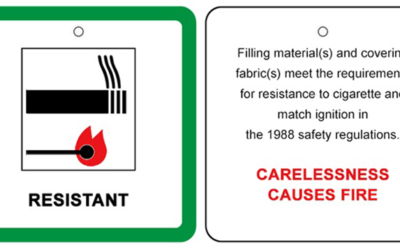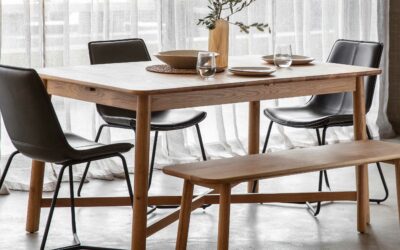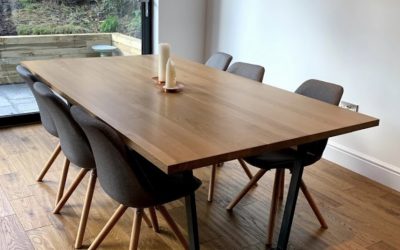6 Ways To Remove Scuff Marks and Scratches from Your Wooden Table
We know all too well that the dining table is a well-used piece of furniture in the home – from daily family meals to kids doing their homework, it’s no surprise that over time your dining table will eventually start showing signs of wear and tear.
Sometimes these are unavoidable, so we have some easy DIY tips and tricks to keep your wooden table looking brand new. These tips are applicable for the table and accompanying benches or chairs if necessary.
Contents
- How To Remove Scratches From Wood Furniture With Sandpaper
- How To Remove Scratches From Wood Furniture With Vinegar
- How To Remove Scratches From Wood Furniture With Crayons
- Fixing Deep Scratches In Wood Tables
- Fixing Other Wooden Table Ailments
- How To Remove Biro For Your Wooden Table
- How To Remove Water Stains From A Wooden Table
- How To Prevent Water Rings On A Wooden Table
How To Remove Scratches From Wood Furniture With Sandpaper
Here are some simple steps on how to remove light scratches or areas of damage on your dining table:
- Most light or surface scratches can be removed by lightly sanding the area with a sanding sponge or sanding block. Make sure you always sand in the direction of the grain. This is because sandpaper puts scratches into your dining table, so the lower the grit (80, 120) the coarser the paper and the deeper the scratches. Going with the grain of the wood allows the scratches to blend in with the natural grain. If you go across the grain the scratches will not blend in and will stand out.
- Light scratches can be removed by initially using fine sandpaper (180 grit) before using something lighter (240 grit) to blend in and minimise the scratches caused by the 180 grit. If the scratches are deeper, you may want to consider a medium sandpaper (120 grit) before this step.
- Finish sanding the area using finer sandpaper (240 grit) in the direction of the grain – this will blend in and remove the scratches caused by the lower grit paper. Make sure that you never jump from coarse sandpaper (120 grit) straight to fine sandpaper (240) as you will see the scratch marks from the coarse paper.
- Once you’ve removed the scratch or mark, ensure you clean all of the dust off the dining table, before refinishing using the oiling or waxing steps in ‘how to oil your dining table’.
Sometimes sandpaper isn’t required to remove really light scratches, you can remove them with some everyday day household items.
How To Remove Scratches From Wood Furniture With Vinegar
For this you’ll need:
- White vinegar (Cider vinegar will also work)
- Olive oil
- Two old cotton rags.
Why do we recommend white vinegar?
White vinegar typically consists of 5% acetic acid and 95% water. These properties not only make it an ideal cleaning solution but they also help repair minor scratches. The acetic acid will work into the existing finish around the scratch to help fill it.
Why do we recommend olive oil?
To repair light scratches you’ll need a stronger solution of white vinegar than you would use to simply clean your table. It’s important to mix the white vinegar with oil, as too high of a concentration of acetic acid can cause damage to the tabletop finish. The olive oil will also improve the overall desired result as it soaks into the exposed wood within the scratch. This helps achieve a darker colour matching the rest of the finish, whilst also protecting the wood from moisture. Lastly, olive oil is a natural product that is food safe, so perfect for using on a surface that you eat from
Nevertheless, we strongly recommend you always apply a solution to a small test area initially to make sure it doesn’t damage the top finish.
Here’s our quick 5 step process to remove scratches with vinegar:
- Mix 100ml (one part) of white vinegar with 200ml (two parts) olive oil in a bowl or a cup and mix well.
Step 1 – Mix Olive Oil and Vinegar
- Dip a soft cotton rag into the cup so that the solution gets soaked into the rag. Squeeze the rag so that there is no excess moisture dripping of it.
Step 2 – Dip Cotton Rag Into Mixture
- Apply the soaked rag to your tabletop over the scratched area. Rub in a circular motion over the scratched area and then finish by rubbing the cloth with the grain.
Step 3 – Apply the Soaked Rag to Your Tabletop
- Let the solution sit on the tabletop surface for 2 minutes. This allows the oil to soak into the scratches.
Step 4 – Leave Mixture on Surface
- Get a clean fresh rag and wipe off the excess solution. Then rub along the grain. Ensure there is no residue left on the tabletop.
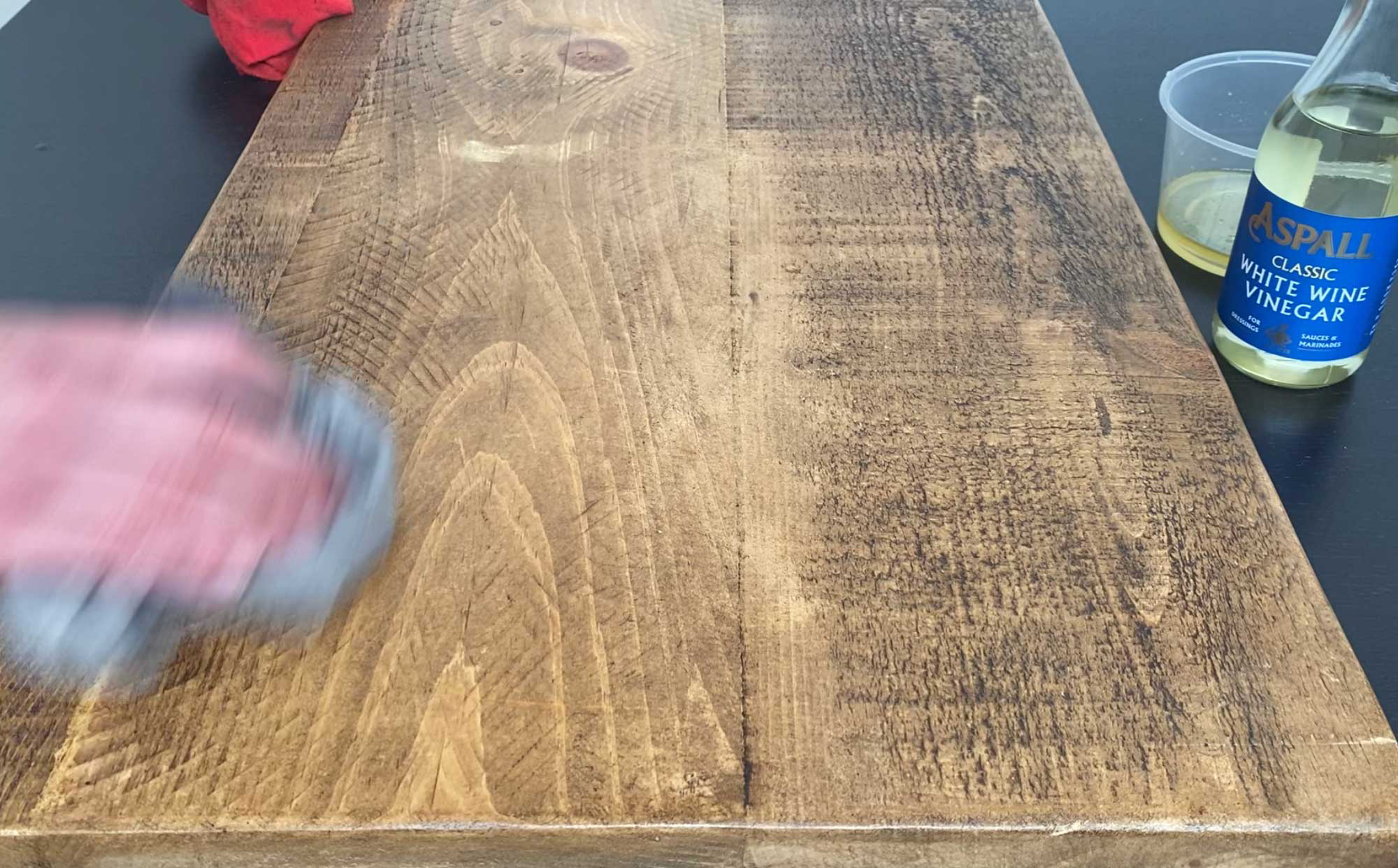
Step 5 – Buff With Fresh Cotton Cloth
This process can be repeated several times until the scratches disappear. If the scratches don’t seem to disappear it could be because your scratches are too deep. If your scratches are too deep then scroll down and continue reading on the next section; how to remove deeper scratches with Crayons.
Sometimes the scratches are too big and the scars too deep to be repaired. If the tips in this blog didn’t work, fear not. Consider a new dining table
👉 “Table beyond repair?“
How To Remove Scratches From Wood Furniture With Crayons
For scratches that are slightly deeper and can’t be removed with vinegar, try using a child’s crayon. A crayon is a fantastic way to remove scratches and here are three reasons why:
- Strength
A crayon is made from a distinct selection of waxes. These waxes have a strengthener added to them to ensure they have structural strength and hold together well in crayon form. So once they’ve filled the small void or scratch on your table, they will become solid like the rest of the wood. - Colour choice
Crayons come in a variety of colours which makes it relatively easy for you to find the perfect match. We’ve chosen the closest wood colours from the Crayola range for you. For natural wood colour tables, we advise ‘Bisque’ and ‘Gold’ Crayola crayons. For medium brown wood tables, we advise ‘Light Brown’ and ‘Golden Beige’ Crayola crayons. Finally, for dark wood tables, we advise ‘Fuzzy Wuzzy’ and ‘Earth Tone’ Crayola crayons. If you’re unsure of what colour crayon to pick, we recommend you always go darker than the actual wood colour of your table as this will give the most natural look. - Food safe
Crayons are made to be suitable for children to use and young children love to put everything in their mouths. As the colours added to the crayons are non-toxic, using them for your dining table won’t be a problem.
Now you know why crayons are great for fixing table scratches, here are five simple steps on how to do it:
- Ensure your table is clean and free of any dust and debris, especially around the area that you would like to repair. If the surface isn’t spotless it can impact the adhesion between the wax and wood.
- Select the crayon colour that matches your dining table wood colour. We would advise that you opt for a darker colour over something lighter, as this improves how the repair blends in with the rest of the surrounding wood.
- Rub the crayon over the scratched area both sideways and lengthways until the scratch is full of wax.
- Use a credit card to gently scrape any excess wax off the table. Ensure that the table surface is now level where the scratch used to be.
- Use a clean cotton rag to buff the wax infill – this will help blend the wax into the tabletop.
This process can be repeated several times to achieve a smooth and flat surface. However, sometimes the scratches or voids may be too deep and wide to eliminate using the method above. If that’s the case, then keep reading.
Fixing Deep Scratches In Wood Tables
- Use a specialised wood filler that matches the colour of your table to fill in the deep scratch. You can use your finger to work it into the scratch, making sure there are no gaps of air.
- Use a putty knife or an old credit card to smooth the surface and remove any excess wood filler from the table.
- Wait for the filler to dry – drying times can vary so ensure you read the packaging for accurate drying times.
- Use fine sandpaper (180 grit or 240 grit) on the dried area around the scratch. Always sand by following the direction of the wood’s grain.
- Apply appropriate oil or wax using the steps above.
Fixing Other Wooden Table Ailments
In the current climate, the dining table is proving to be a multifunctional piece of furniture. Whether you use it for eating meals, a home office desk for those working at home, a school classroom for the kids or working on your arts and crafts skills. This opens your wooden table up to a wide range of potential damages, there are many tips and tricks that you can use to ensure your table maintains good health.
How To Remove Biro For Your Wooden Table
A dining table is a perfect place for home working and schooling. However, one common problem that’s likely to occur is getting biro ink onto the surface of your dining table.
Before we recommend the process to remove biro, it’s important to point out that the success of the process will depend on how your dining table is finished. If your wooden dining table is a wax or oil finish it can be a lot more difficult to remove the biro – the steps below will most likely strip the wax and oil from the area of the biro so the area will have to be re-oiled/waxed. If the biro has penetrated the wood you should read the section ‘how to remove scratches from wood furniture with sandpaper and apply the same process to your table to fully repair.
Varnish and Lacquer finishes provide a strong protective layer over the top surface of the wood. This means that the ink is less likely to have penetrated the wood so the biro can be more easily removed.
We recommend that you squeeze some rubbing alcohol or even hand sanitizer on the area where there are biro or ink stains and let it sit for 10 minutes. If the ink seems to be trapped within the grain of a wooden table, it is best to use a cotton ball or cloth and rub over the ink in circular motions to help penetrate the trapped ink.
Ensure that the table is wiped and there is no alcohol left on the table. If there are any remnants of ink left on the table you can repeat this process.
How To Remove Water Stains From A Wooden Table
Nothing quite stands out like a white water stain on a dining table. Water stains are often in the form of white rings since the main culprit is the bottom of cold glasses or hot mugs being put directly on top of a wooden table. However, they’re not always in a ring form as any cold or hot item can create marks, such as hot serving dishes or spilt drinks and food. The white marks cloudy appearance is due to water being trapped on the table’s surface finish. This is from either the condensation of the cold items or the steam of the hot items.
It’s important to note that if your watermark is not white but is a dark brown or black colour, this means that the water has penetrated through your table finish and caused damage to the wood itself. This can usually be fixed by sanding the area down and re-applying a protective finish, although this depends on how deep the damage is into the wood. Read how to remove scratches from wood furniture with sandpaper and follow the steps.
If you have white cloudy watermarks on your table the best thing to do is try to remove the trapped water in the top finish. The easiest way to do this is to use a hairdryer or heat gun; the heat will evaporate the water helping it escape from the finish. Here are some simple steps to ensure you remove the stains safely without damaging your table further:
- Set your hairdryer to medium to high temperature
- Hold it around 10cm away from your tabletop and move it side to side over the stained area. You shouldn’t smell any burning – if you do make sure you lower the heat or go further away from the tabletop.
- After 2-3 minutes you should start to see the stain start to fade.
- Keep it over the area for 15-20 minutes or until the stain has disappeared fully.
If the watermark has been on the table for a while it may not completely disappear. We advise that you now follow this step by applying a tablespoon of Mayonnaise to the area and covering with a piece of kitchen towel overnight. This may seem odd but mayonnaise contains a mixture of oil and vinegar. The oil will slowly seep into the wood overnight helping restore the table’s colouring, whilst the vinegar contains acetic acid which helps break down the surrounding finish allowing the restored area to blend in with the existing finish.
Overall, these little tips and tricks should help save your dining table from water stains.
How To Prevent Water Rings On A Wooden Table
Unfortunately, if you are reading this then you have likely already experienced water rings on your wooden table. Here are some of our top tips to prevent water rings on a wooden table in future:
- You need to avoid putting cold and hot drinks directly onto your wooden table. You must protect your table from moisture and heat, so make sure your coasters are stored close to or on your table ready to use.
- Don’t place hot or cold plates or serving dishes directly on your table, instead use a placemat to protect your table.
- Wipe up spillages off your table as soon as you notice them.
- When cleaning your table don’t let it air dry. Use a dry towel to ensure all the moisture is removed from the table straight away.
You must care for your wooden table to improve its longevity in your home. For more advice on how you can look after your table, be sure to read our detailed guide in maintaining your wooden table. Alternatively, you may be interested in our guide to caring and treating oak furniture.
Table beyond repair?
Sometimes the scratches are too big and the scars too deep to be repaired. If the tips in this blog didn’t work, fear not. Consider a new dining table manufactured with love in the UK by Grain and Frame. Our stunning, solid wood tables come in a wide range of styles, from contemporary to rustic and farmhouse designs.
At the very least, have a look 🙂
